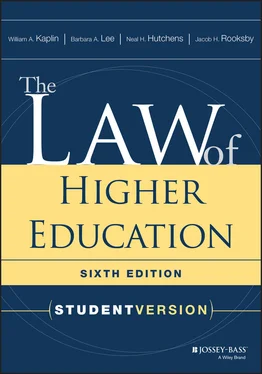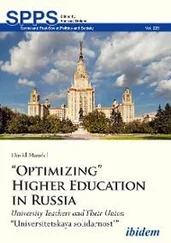2.4.3 Enterprise risk management.In recent years, universities have been considering and implementing more comprehensive programs for risk assessment, management, and prevention, which can be grouped under the category of “enterprise risk management” (ERM). ERM focuses on various risk areas within an institution, such as strategic, competitive, operational, reputational, and financial risks, among others. The goal of ERM is to manage risk across the university in a holistic way, which requires buy-in from all levels in the university.
For an overview of enterprise risk management and its interplay with insurance, see https://www.naic.org/cipr_topics/topic_enterprise_risk_management.htm.
1 1Another branch of judicial deference that is highly important to higher education arises when an institution, or an association of institutions, challenges a rule or decision of a federal or state administrative agency in court. Questions may then arise concerning the extent to which the court should defer to the expertise or authority of the administrative agency.
2 2Some personnel disputes will have gone to arbitration before landing in court. When an institution prevails in arbitration and the faculty member then files suit in court, the institution has an additional argument for deference: that the court should accord deference not only to the institution's judgment but also to the arbitrator's decision. See, for example, Samoan v. Trustees of California State University and Colleges, 197 Cal. Rptr. 856 (Cal. 1983).
3 3The suggestions in this section apply not only to litigation against the institution but also to suits against officers or employees of the institution when the institution is providing them, or considering providing them, with legal representation or related assistance. In suits in which both the institution and one or more named institutional officers or employees are defendants, questions may arise concerning possible conflicts of interest that could preclude the institution's legal staff from representing all or some of the officers or employees (see Section 2.4.3).
4 4Information about ombudspersons may be found on the website of the International Ombudsman Association ( www.ombudsassociation.org).
5 5Steelworkers v. American Manufacturing Co., 363 U.S. 564 (1960); Steelworkers v. Enterprise Wheel and Car Corp., 363 U.S. 593 (1960); and Steelworkers v. Warrior and Gulf Navigation, 363 U.S. 574 (1960).
6 6 This section was revised and updated by Jonathan R. Alger, former senior vice president and general counsel at Rutgers University and currently president of James Madison University.
PART TWO THE COLLEGE AND ITS GOVERNING BOARD AND STAFF
3 The College's Authority and Liability
Chapter 3 addresses the concept of authority—specifically, the college or university's authority to take particular actions and its potential legal liability for exercising authority in certain ways. Explanations are given for three types of authority ( express, implied, and apparent authority) and three types of liability (tort law [especially negligence], contract law, and civil rights liability). More specifically, the institution's potential premises liability (for allegedly unsafe buildings and grounds) is discussed, followed by liability for injuries related to on- and off-campus courses, cocurricular activities, and liability related to student suicide. Institutional contract liability is then addressed, including the question of an institution's (or an individual's) authority to enter a contract that will bind the institution. Finally, the institution's potential liability for civil rights violations under Section 1983 of the Civil Rights Act is examined, along with the defense of sovereign immunity .
Section 3.1. The Question of Authority
3.1.1 Overview.Trustees, officers, and administrators of postsecondary institutions—public or private—may take only those actions and make only those decisions that they have authorityto take or make. Acting or deciding without authority to do so can have legal consequences, both for the responsible individual and for the institution. It is thus critical, from a legal standpoint, for trustees, officers, and other administrators to understand and adhere to the scope and limits of their authority and that of other institutional functionaries with whom they deal. Such sensitivity to questions of authority will also normally be good administrative practice, since it can contribute order and structure to institutional governance and make the internal governance system more understandable, accessible, and accountable to those who deal with it.
Authority generally originates from some fundamental legal source that establishes the institution as a legal entity. For public institutions, the source is usually a state constitution or state authorizing legislation; for private institutions, it is usually articles of incorporation, sometimes in combination with some form of state license. These sources, though fundamental, are only the starting point for legal analysis of authority questions. To be fully understood and utilized, an institution's authority must be construed and implemented in light of all the sources of law described in Section 1.4. For public institutions, state administrative law ( administrative procedure actsand similar statutes, plus court decisions) and agency law (court decisions) provide the backdrop against which authority is construed and implemented; for private institutions, state corporation law or trust law (statutes and court decisions) plus agency law (court decisions) are the bases. Authority is particularized and dispersed (delegated) to institutional officers, employees, committees and boards, and internal organizations such as a faculty senate or a student government. The vehicles for such delegations are usually the governing board bylaws, institutional rules and regulations, the institution's employment contracts, and, for public institutions, the administrative regulations of state education boards or agencies. Authority may also be delegated to outside entities such as an athletic booster club, a university research foundation, or a private business performing services for the institution. Vehicles for such delegations include separate corporate charters for captive organizations, memoranda of understanding with affiliated entities, and service contracts (for contracting out of services). Gaps in internal delegations may be filled by resort to the institution's customs and usages, and vagueness or ambiguity may be clarified in the same way. For some external delegations, the custom and usage of the business or trade involved may be used in such circumstances rather than that of the institution.
There are several generic types of authority. As explained in Brown v. Wichita State University ( Section 3.3), authority may be express, implied, or apparent. “Express authority” is that which is found within the plain meaning of a written grant of authority. “Implied authority” is that which is necessary or appropriate for exercising express authority and can therefore be inferred from the express authority. “Apparent authority” is not actual authority at all; the term is used to describe the situation where someone acting for the institution induces a belief in other persons that authority exists when in fact it does not. Administrators should avoid this appearance of authority and should not rely on apparent authority as a basis for acting, because the institution may be held liable, under the doctrine of estoppel, for resultant harm to persons who rely to their detriment on an appearance of authority. When an institutional officer or employee does mistakenly act without authority, the action can sometimes be corrected through “ratification” by the board of trustees or other officer or employee who does have authority to undertake the act in question.
Читать дальше












